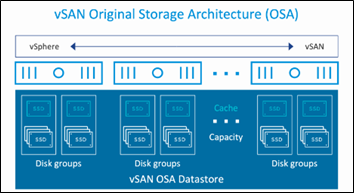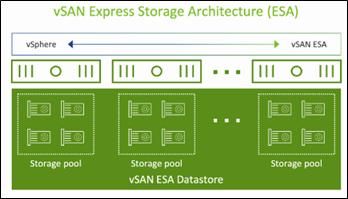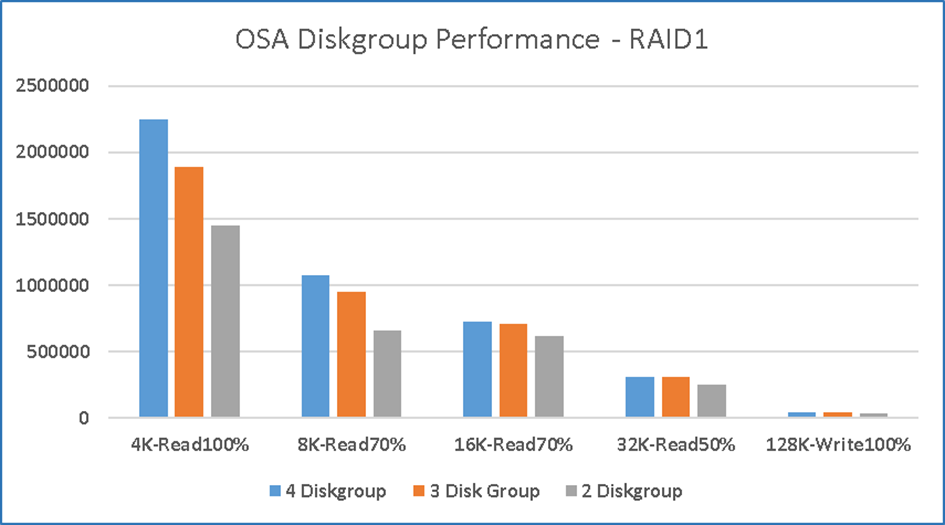Author
Updated
28 May 2024Form Number
LP1872PDF size
13 pages, 790 KB- Business Trends
- Lenovo ThinkAgile VX Solutions for VMware vSAN
- Comparison of vSAN OSA and ESA Solutions
- ThinkAgile VX and vSAN Storage Architectures
- VMware Horizon VDI Performance on vSAN ESA vs. OSA
- HCIBench FIO Benchmark on vSAN OSA and ESA
- Constant Latency Testing with 4th Gen Intel Xeon Processors
Abstract
This technical brief highlights the performance results of vSAN Original Storage Architecture (OSA) and vSAN Express Storage Architecture (ESA) across different scenarios, and provides design guidance when using the vSAN storage architectures. Lenovo ThinkAgile VX650 V3 and VX630 V3 models with 4th Gen Intel Xeon Scalable processors were used in the testing. The ThinkAgile VX Series is hyperconverged infrastructure (HCI) based on VMware vSAN.
Change History
December, 2023 - Initial release
May, 2024 - Updated LoginEnterprise tool results with VMware Horizon VDI and HCIBench tool results with a variety of applications. Constant latency testing was also completed with 4th Gen Intel Xeon processors. Updated OSA and ESA performance figures with 25 GbE and 100 GbE.
Business Trends
Software Defined Datacenter Architecture: The growth of technology, modern applications, cloud, artificial intelligence and data-driven ecosystems bring the need for on-premises infrastructure to meet high performance and high-density workload requirements across datacenters. Servers need to have software defined solutions to build robust storage systems and integrated software stack for cloud and cloud native technologies and third-party software to build flexible and scalable architecture to meet any workload. This trend means businesses need faster servers and storage to achieve the performance and low latency required.
Infrastructure and Workloads Modernization: Adoption of hybrid cloud, artificial intelligence and machine learning and open source technologies drives enablement for tens of software and applications to coexist on the shared infrastructure and need increased processing and data storage capabilities. Ever growing data and AI/ML workloads require storage system with low latency and high capacity drives, high speed network adapters and interconnects that are pre-tested and pre-validated engineered solution to reduce deployment complexities. Business needs for consolidation enterprise workloads and rapid provision end-end infrastructure and software stack without compromising performance and integration capabilities.
Lenovo ThinkAgile VX Solutions for VMware vSAN
Lenovo ThinkAgile VX systems are the perfect choice for hyperconverged infrastructure and provide an outstanding platform to support the different VMware vSAN™ architectures. Lenovo and VMware's over 20 year partnership and collaboration continues to strongly drive innovation and technical enablement for vSAN-based storage solutions. This includes validation, certification, configuration and support for ThinkAgile VX systems.
Lenovo ThinkAgile VX V3 hyperconverged systems are equipped with 4th generation Intel® Xeon® Scalable processors and VMware vSAN 8. They are Accelerated by Intel offerings that drive greater performance for CPU and IO intensive workloads.
Lenovo ThinkAgile VX servers are available as Integrated Systems and Certified Nodes. Both are factory integrated, pre-configured systems with Lenovo hardware, VMware software, and deployment services. VX Integrated Systems provide a quick and convenient path to implement a hyperconverged solution powered by VMware vSAN and a single point of contact provided by Lenovo for purchasing, deploying, and supporting the solution. VX Certified Nodes come with optional VMware software and services.
ThinkAgile VX Integrated Systems can also be up and running quickly with a web-based deployment wizard. The installer can install and configure VMware ESXi, vCenter Server and Lenovo XClarity Integrator and either create or join a cluster.
Lenovo ThinkAgile VX systems support all vSAN architectures:
Comparison of vSAN OSA and ESA Solutions
The table below shows a basic comparison of vSAN OSA and ESA solutions.
ThinkAgile VX and vSAN Storage Architectures
|
Applications where the servers would excel include:
|
The following sections provide benchmark results for Login Enterprise (VDI) and HCIBench (FIO) benchmark done on ESA and OSA configurations.
VMware Horizon VDI Performance on vSAN ESA vs. OSA
The Login Enterprise VDI benchmark was performed for the ”knowledge worker profile” on a 4 node ThinkAgile VX650 V3 Integrated System cluster with 2x Intel® Xeon® Platinum 8468 48C processors for both vSAN OSA and vSAN ESA with 1500 users. The test was done with the following software versions and configuration:
- LoginEnterprise 5.1.2
- VMware ESXi, 8.0.1-21495797, Instant Clone
- VMware Horizon 8.9.0 build 21593375 v2303
- Microsoft Windows 10 Enterprise Edition
- Microsoft Office Professional 2007, Microsoft Edge
- 3 VCPU + 2 GB Memory + 40 GB disk
The knowledge worker profile generates 10-15 IOPS per user during steady state and is not a storage intensive benchmark.
| OSA | ESA |
|---|---|
| 2 disk groups Cache tier - 2 x ThinkSystem P5620 1.6TB Mixed Use NVMe PCIe 4.0 Capacity tier - 4 x ThinkSystem S4520 1.92TB Read Intensive SATA 6Gb HS SSD drives |
8 x ThinkSystem P5620 3.2TB Mixed Use NVMe PCIe 4.0 drives |
| RAID 1 | RAID 5 |
| 25 GbE | 25 GbE |
| RDMA Enabled | RDMA Enabled |
| VSIMAX = 1428 | VSIMAX = 1395 |
The Login Enterprise VSIMax provides desktop density at 100% CPU utilization. The performance of knowledge worker profile looks similar for both ESA and OSA architectures and ESA provides slightly higher density. The office applications response time and latency with ESA is better than OSA tests. The spike in response time at 190th minute is due to saturation of CPU and new users are trying to login and launch applications. It is recommended to design and size CPU capacity at no more than 70-80% to leave headroom to accommodate peak load and failover scenarios.

Figure 4. Login Enterprise Test Results with vSAN ESA and OSA
HCIBench FIO Benchmark on vSAN OSA and ESA
The HCIBench tool (version 2.8.2 and FIO 3.3) was used for measuring performance for OSA and ESA. The constant load scenario objective is to measure actual I/O latency on the storage during normal I/O operations and it does not let system reach maximum IOPS which can result in increase in latency.
| VM Configuration | Constant Latency Scenario |
|---|---|
| Warm up before testing | 5 mins |
| VCPU | 4 |
| Memory | 8 GB |
| No. of data disks | 8 |
| Disk size | 50 GB |
| IO rate | 100% |
| FIO settings | ioengine=libaio iodepth= (1-32, refer next table) |
| Total number of VMs | 16 (4 per node) |
Table below shows different IO scenarios tested with HCIBench and each scenario matches with one or more real world use cases.
| Scenario | Block size | Iodepth | Read % | Write % | Random % | Workload Category |
|---|---|---|---|---|---|---|
| 4K-Read 100% | 4K | 32 | 100% | 0% | 100% | Read-intensive workload |
| 8K-Read 70% | 8K | 16 | 70% | 30% | 100% | NoSQL, Dey Value, Generic web workloads |
| 16K-Read 70% | 16K | 8 | 70% | 30% | 70% | Files and relational databases |
| 32K-Read 50% | 32K | 4 | 50% | 50% | 50% | SQL |
| 128K-Write 100% | 128K | 1 | 0% | 100% | 0% | Write-intensive workload |
Constant Latency Testing with 4th Gen Intel Xeon Processors
Lenovo performed HCIBench constant latency scenario with fixed IO depth value to measure OSA and ESA throughput on 25 GbE and 100 GbE networks. The benchmark was done on 4x Lenovo ThinkAgile VX650 V3 servers, each with Intel Xeon Platinum 8468 48C processors.
| OSA | ESA |
| 3 disk groups Cache tier - 3 x ThinkSystem P5620 1.6TB Mixed Use NVMe PCIe 4.0 x 4 HS SSD Capacity tier - 12 x ThinkSystem PM1653 1.92TB Read Intensive SAS 24Gb HS SSD |
8 x ThinkSystem P5620 3.2TB Mixed Use NVMe PCIe 4.0 x 4 HS SSD |
| 2 x ThinkSystem Mellanox ConnectX-6 Lx 10/25 GbE SFP28 2-port 2 x ThinkSystem Mellanox ConnectX-6 Dx 100 GbE QSFP56 2-port PCIe ethernet adapters |
2 x ThinkSystem Mellanox ConnectX-6 Lx 10/25 GbE SFP28 2-port 2 x ThinkSystem Mellanox ConnectX-6 Dx 100 GbE QSFP56 2-port PCIe ethernet adapters |
| RAID 1 | RAID 5 |
| 25 GbE, 100 GbE | 25 GbE, 100 GbE |
| RDMA Enabled | RDMA Enabled |
| VMware ESXi, 8.0.1-21495797 | VMware ESXi, 8.0.1-21495797 |
OSA vs ESA performance on 25 GbE and 100 GbE NIC
- vSAN ESA leverages 100 GbE network and provides up to 250% better performance than 25 GbE for many of the scenarios except 100% read scenarios. ESA can provide more throughput by increasing IO depth and removing constant latency factor. Refer to results for HCIBench maximum throughput scenario here.
- vSAN OSA performance on both 25 GbE and 100 GbE are similar for the scenarios 8K- Read70% and 128K-Write100%. The scenarios 16K-Read70% and 32K-Read50% provide 20-50% more throughput with 100 GbE. vSAN OSA with 3 disk groups perform better than ESA with 25 GbE network.
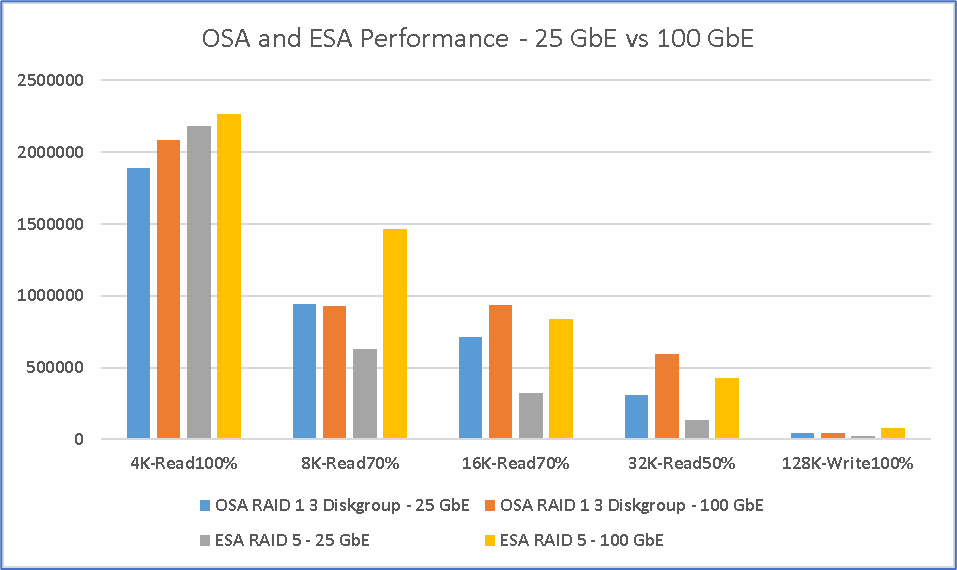
Figure 5. HCIBench Constant Latency Load Results – OSA RAID 1 vs ESA RAID 5 – 25 GbE vs 100 GbE
vSAN OSA Disk Group Scalability
Figure below shows 25 GbE throughput results for different number of disk groups for vSAN OSA. The throughput increases by 10-30% range for a greater number of disk groups while the write-only scenarios do not show considerable benefits. Adding more disk groups does require more cache drives and capacity drives which increases TCO.
Design Guidelines for OSA and ESA
Both vSAN OSA and ESA are scalable solutions and ESA reduces storage footprint up to 40% and also it can accommodate 60% more virtual machines. vSAN OSA supports vSphere 7 & 8 and provides support for a wide number of options with NVMe, SSD and HDD and the cache tier provides improved performance for many workloads. The vSAN cluster configuration should be balanced for CPU, memory and storage requirements based on the workloads running on them and the cluster must be either scaled up or scaled out appropriately. These aspects need to be considered during initial assessment. The table below provides a comparison between vSAN OSA and ESA features and supported configurations.
| Feature | OSA | ESA |
|---|---|---|
| vSphere Support | ESXi 7.x, 8.x | ESXi 8.x |
| Drive Options |
|
All NVMe |
| TCO |
|
|
| Maximum Capacity Per Node |
|
|
| Scale Up |
|
Capacity can be increased by adding more drives without any dependencies |
| Scale Out |
|
Add nodes and disk drives |
| Disk Maintenance |
|
Drives can be added/removed easily, and data migration is at the disk level |
| Compression | Enabled at vSAN datastore level and causes CPU overhead and performance impact | Enable/disabled at storage policy level. No overhead on performance. |
| Optimal Performance | RAID 1 | RAID 5 and RAID 6 based on cluster size |
Accelerated by Intel
To deliver the best experience possible, Lenovo and Intel have optimized this solution to leverage Intel capabilities like processor accelerators not available in other systems. Accelerated by Intel means enhanced performance to help you achieve new innovations and insight that can give your company an edge.
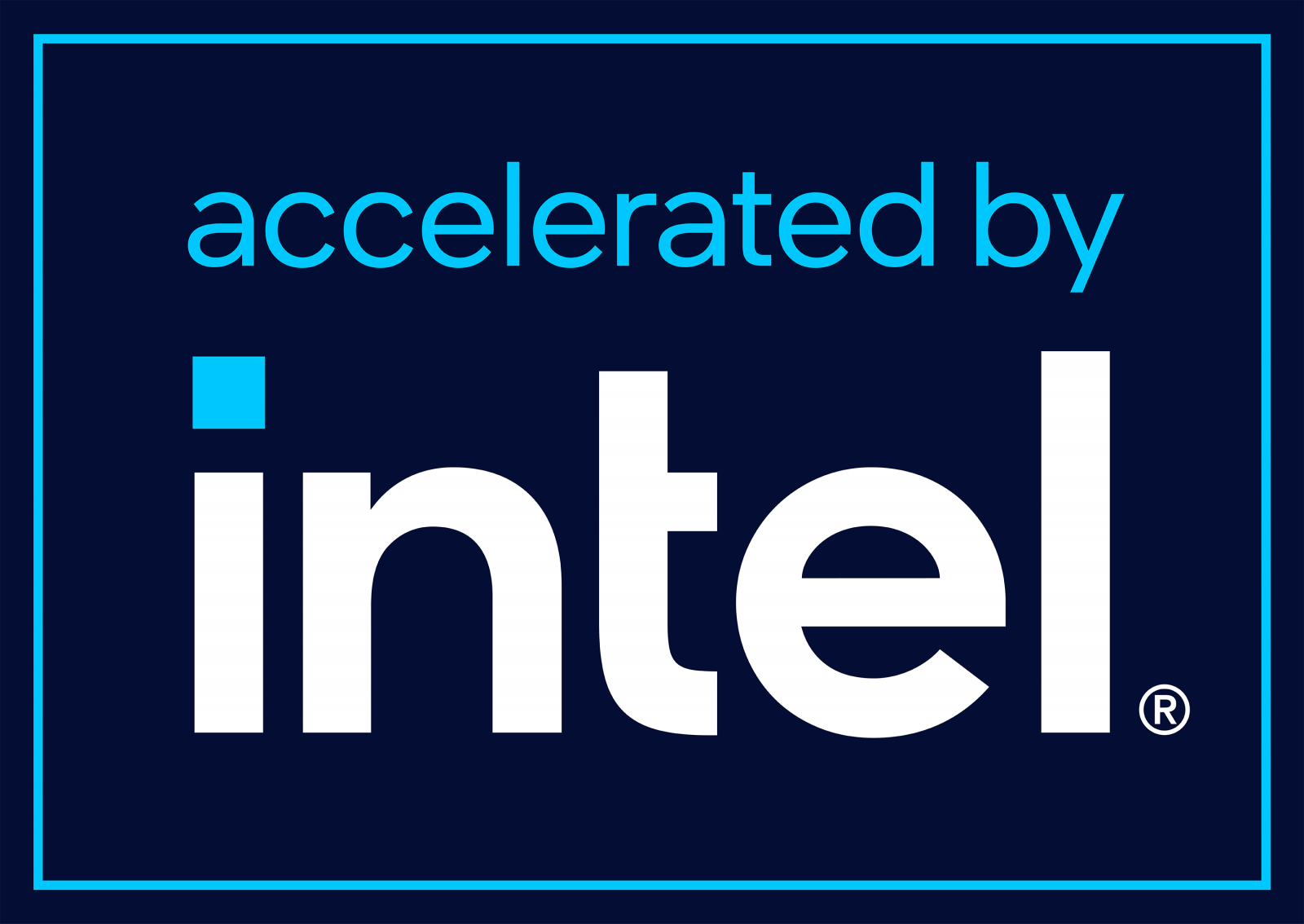
Lenovo and VMware
With co-located engineering organizations and a history of technical collaboration, VMware and Lenovo consistently deliver innovative joint solutions for the data center. Lenovo’s leadership in reliability, customer satisfaction, and performance, combined with VMware’s leadership in software and cloud services, continues to deliver innovative data center solutions and lower TCO for our joint customers.
Why Lenovo
Lenovo is a US$70 billion revenue Fortune Global 500 company serving customers in 180 markets around the world. Focused on a bold vision to deliver smarter technology for all, we are developing world-changing technologies that power (through devices and infrastructure) and empower (through solutions, services and software) millions of customers every day.
For More Information
To learn more about workload solutions on Lenovo ThinkAgile VX630 V3 and VX650 V3, contact your Lenovo Business Partner or visit: https://www.lenovo.com/us/en/servers-storage/sdi/thinkagile-vx-series/
References:
Lenovo ThinkAgile VX630 V3 1U Integrated Systems and Certified Nodes: https://lenovopress.lenovo.com/lp1672
Lenovo ThinkAgile VX650 V3 2U Integrated Systems and Certified Nodes: https://lenovopress.lenovo.com/lp1673
VMware vSAN Design Guide: https://core.vmware.com/resource/vmware-vsan-design-guide
VMware ESA Ready Node Hardware Guidance: https://www.vmware.com/resources/compatibility/vsanesa_profile.php
Trademarks
Lenovo and the Lenovo logo are trademarks or registered trademarks of Lenovo in the United States, other countries, or both. A current list of Lenovo trademarks is available on the Web at https://www.lenovo.com/us/en/legal/copytrade/.
The following terms are trademarks of Lenovo in the United States, other countries, or both:
Lenovo®
ThinkAgile®
ThinkSystem®
XClarity®
The following terms are trademarks of other companies:
Intel®, the Intel logo and Xeon® are trademarks of Intel Corporation or its subsidiaries.
Microsoft®, Microsoft Edge, and Windows® are trademarks of Microsoft Corporation in the United States, other countries, or both.
Other company, product, or service names may be trademarks or service marks of others.
Configure and Buy
Full Change History
Course Detail
Employees Only Content
The content in this document with a is only visible to employees who are logged in. Logon using your Lenovo ITcode and password via Lenovo single-signon (SSO).
The author of the document has determined that this content is classified as Lenovo Internal and should not be normally be made available to people who are not employees or contractors. This includes partners, customers, and competitors. The reasons may vary and you should reach out to the authors of the document for clarification, if needed. Be cautious about sharing this content with others as it may contain sensitive information.
Any visitor to the Lenovo Press web site who is not logged on will not be able to see this employee-only content. This content is excluded from search engine indexes and will not appear in any search results.
For all users, including logged-in employees, this employee-only content does not appear in the PDF version of this document.
This functionality is cookie based. The web site will normally remember your login state between browser sessions, however, if you clear cookies at the end of a session or work in an Incognito/Private browser window, then you will need to log in each time.
If you have any questions about this feature of the Lenovo Press web, please email David Watts at dwatts@lenovo.com.



